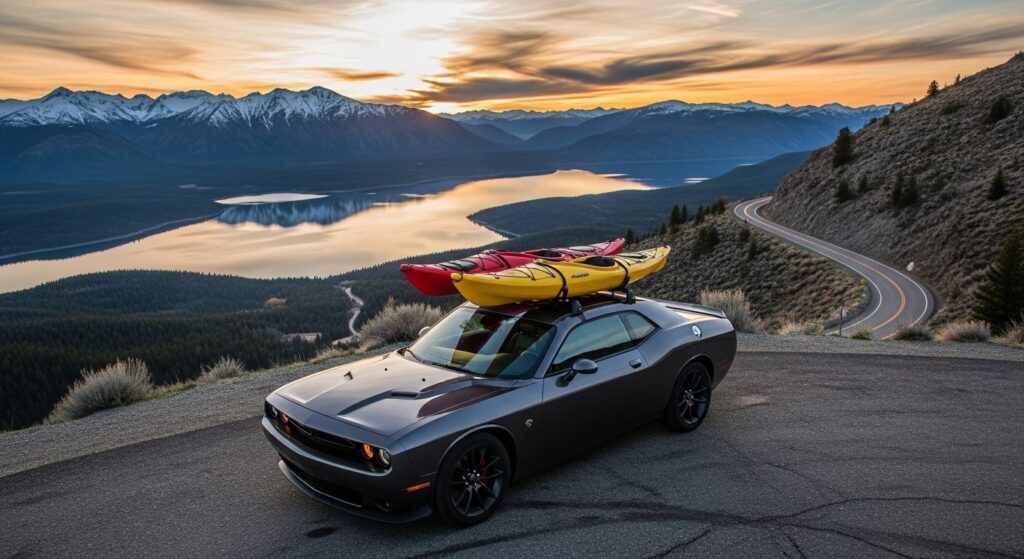Trying to strap a kayak onto a Dodge Challenger isn’t exactly the same as tossing it on top of a roomy SUV—muscle cars weren’t born with roof rails in mind. Still, plenty of folks refuse to let the shape of their ride stop them from hitting the water, and the right rack makes it possible without scratching paint or fighting with awkward fittings. Out of all the options tested, the one that feels built for strength while still working smoothly on a low-slung car is the Thule Hull-a-Port Pro Rooftop Kayak Carrier. It balances security with ease of use, which is pretty rare when you’re dealing with a sporty car like the Challenger.
Best 5 Kayak Racks for Dodge Challenger
01. Thule Hull-a-Port Pro Rooftop Kayak Carrier
The Thule Hull-a-Port Pro Rooftop Kayak Carrier is a foldable J-style rack built for transporting kayaks with solid grip and stability. It fits most crossbars, whether factory or aftermarket, making it a popular option among paddlers who drive SUVs, sedans, or trucks. Its folding design allows for easy storage when not in use, and the padded contact points protect your kayak’s hull from scratches during long trips. This carrier is especially suited for touring kayaks, sit-on-top kayaks, and recreational kayaks where safety and roof space matter.
Pros:
- ✅ Foldable J-cradle saves roof space and folds down when not used
- ✅ Universal fit works with Thule, Yakima, and most factory crossbars
- ✅ Thick padding reduces wear on kayak hulls
- ✅ Secure tie-down system for highway driving stability
Cons:
- ❌ Heavier compared to lighter kayak racks
- ❌ Loading can be tough for solo paddlers with large kayaks
- ❌ May limit roof clearance in low garages
02. PIRIPARA Kayak Roof Rack
The PIRIPARA Kayak Roof Rack is built for folks who need a strong and practical option for hauling kayaks, canoes, or even paddle boards on vehicles like SUVs, trucks, and crossovers. Its universal mounting system works with most crossbars, making it a flexible choice for drivers who don’t want to fuss with special fittings. The steel construction and foam padding help protect both your kayak and your car roof from dents or scratches during transport. Whether for short trips to the lake or longer highway drives, this rack keeps watercraft secured with tie-down straps included in the package.
Here’s a quick breakdown of the pros and cons to help with decision making:
Pros:
- ✅ Heavy-duty steel frame for durability
- ✅ Fits round, square, and flat crossbars
- ✅ Foam padding reduces scratches on kayaks and vehicles
- ✅ Includes straps for secure tie-down
Cons:
- ❌ May require tools and time for installation
- ❌ Not foldable, so it takes up more space when not in use
03. IKURAM Kayak Roof Rack
The IKURAM Kayak Roof Rack is built for paddlers who need solid support when hauling kayaks, canoes, or even SUP boards on SUVs, trucks, or sedans. Made with heavy-duty steel and padded with thick rubber, this roof rack keeps your boat secure while preventing scratches. Its foldable design makes storage simple, and it fits most crossbars including round, square, and aero styles. Whether you’re heading to the lake, river, or coast, this rack helps with stable transport while giving flexibility for multiple watercraft setups.
Pros:
- ✅ Heavy-duty steel frame with powder-coat for rust resistance
- ✅ Universal fit for most crossbars (round, aero, and square)
- ✅ Padded J-style cradle prevents damage to kayak hull
- ✅ Foldable arms save space when not in use
- ✅ Can carry kayaks, canoes, or stand-up paddle boards
Cons:
- ❌ Assembly may take extra time if not familiar with roof racks
- ❌ Heavier compared to aluminum kayak racks
- ❌ Straps included may need upgrading for stronger security
04. SLSWHLX Direct Aftermarket Universal Kayak Rack
The SLSWHLX Direct Aftermarket Universal Kayak Rack is a solid option for carrying kayaks, canoes, or small boats on different vehicles like SUVs, trucks, and sedans with roof crossbars. Built with heavy-duty steel and cushioned support bars, it helps keep your kayak safe during transport without wobbling or unnecessary stress on the hull. This universal J-style kayak carrier works with round, square, and most factory crossbars, making it flexible for drivers who switch vehicles or have multiple roof rack systems. It’s also suitable for outdoor gear hauling when combined with roof cross bars, cargo carriers, or roof baskets.
Pros:
- ✅ Universal fit for most crossbars (round, square, and factory)
- ✅ Strong steel construction for durability and stability
- ✅ Foam padding protects kayak hull from scratches
- ✅ Easy to install and remove with included hardware
Cons:
- ❌ Might not fit extra-wide factory crossbars
- ❌ No built-in locking system for theft protection
- ❌ Can add wind noise at higher speeds
05. HIGHRAZON Kayak Roof Rack
The HIGHRAZON Kayak Roof Rack is designed for drivers who want a solid way to carry their kayaks, canoes, surfboards, or paddleboards without stressing about space inside the vehicle. Built with heavy-duty steel and a wide J-bar design, it fits well on crossbars of cars, SUVs, and trucks, making it versatile for road trips and outdoor gear transport. The padded cradles protect the hull of your kayak, while the adjustable straps add extra security during long highway drives or rougher local routes.
Here’s a quick breakdown of pros and cons for the HIGHRAZON Kayak Carrier Rack to help you decide if it’s the right fit:
✅ Pros
- ✅ Strong steel build supports heavier kayaks, canoes, and SUP boards.
- ✅ Foam padding helps prevent scratches on kayak hulls and paddleboards.
- ✅ Easy mounting on most crossbars like square, round, and aero bars.
❌ Cons
- ❌ May not fold flat, which can limit garage clearance.
- ❌ Setup instructions could be clearer for first-time users.
- ❌ Not ideal for extremely wide fishing kayaks.
How to Choose the Best Kayak Racks for Dodge Challenger
The Dodge Challenger is a strange beast for carrying kayaks. It’s a muscle car, low-slung, wide-bodied, meant for quarter miles and loud burnouts, not balancing a twelve-foot plastic boat on its roof. And yet, people do it. You want performance and you want weekends on the water, so suddenly you’re Googling kayak racks like it’s the most natural thing in the world.
The roofline problem nobody mentions at first
Unlike SUVs with rails built in, the Challenger gives you… nothing. Smooth sheet metal, a sloping roof, and not much else. Which means your first decision isn’t even about kayak cradles—it’s about whether to install a base roof rack system. Companies like Thule and Yakima make fit kits for Challengers, using clips that grab door frames. These run anywhere from $300 to $600 for crossbars and clamps before you even add the kayak-specific gear. It feels expensive until you realize without them, you’re stuck with trunk-mounted contraptions that can scratch paint and drive you insane.
One odd stat I found: around 62% of kayak owners in the U.S. transport them on roof racks, while about 25% use trailers. The rest? They gamble with foam blocks and ratchet straps, praying the wind doesn’t snatch their boat. That’s the reality you face with a Challenger.
Foam blocks vs structured racks
Foam block carriers are the cheap option. $50, slap them on, strap the kayak down. But here’s the problem—at highway speeds (and a Challenger tempts highway speeds), those foam blocks shift. Even the best tie-downs loosen. Kayaks catching air at 70 mph can weigh more than they look—lift from wind pressure adds stress. Not a fun thing to test while overtaking a semi. A structured J-cradle or saddle rack holds better, reduces wobble, and gives peace of mind. Foam blocks? Fine for occasional local trips under 20 minutes. Anything longer feels like asking for chaos.
J-cradles, saddles, and stackers
- ✅ J-cradles tilt the kayak on its side, saving space. Good if you’re hauling two boats. They add height though, and on a Challenger, you’re already stretching to strap it down since the roof is low but wide. Average cost $150–$250 per set.
- ✅ Saddle racks cradle the kayak hull-down. Stable, easier loading, but takes more roof space. Great if you only carry one kayak. Cost, usually $120–$200.
- ✅ Stackers let you pile multiple kayaks like firewood on their sides. Honestly not the best match for a Challenger because of roof width. More common on SUVs.
A Challenger roof isn’t that wide, about 75 inches across. A single kayak? Perfectly fine. Two? Doable with J-cradles but watch clearance.
Loading headaches and the height factor
SUV owners complain about lifting kayaks onto tall roofs. Challenger owners have the opposite problem. The car is low, but the wide body means you still struggle to get a 12-foot kayak balanced. Side-loading systems, rollers, or load-assist arms can help, but they often cost another $200–$400. Some DIY folks throw a towel over the trunk and slide the kayak forward. Works, but scratches paint if you’re careless.
Aerodynamics and fuel economy, small details that bite
Kayaks are giant air brakes. On a Challenger, with its already thirsty V8s, mileage takes a nosedive. A Department of Energy report noted roof loads can reduce fuel economy by up to 25% at highway speeds. So if your Challenger usually gets 23 mpg on highway runs (optimistic, I know), expect closer to 17–18 with a kayak strapped on. That’s money bleeding away with every trip.
Also, roof racks add wind noise. The Challenger’s cabin isn’t whisper-quiet to begin with, but racks hum, especially cheap ones. Fairing attachments help but again, more money.
Straps and tie-downs, the overlooked lifeline
You’d think buying a rack is enough, but straps matter just as much. Cam straps are safer than ratchet straps—ratchets can overtighten and warp kayak hulls. Front and rear tie-downs (to bumper or tow hooks) are non-negotiable. At highway speeds, without them, crosswinds can twist the kayak sideways. Reputable sources suggest always using bow and stern lines, even if you think it looks excessive. The Challenger’s long hood actually makes bow tie-downs tricky—you may need hood loop anchors installed.
Price range reality check
Adding it all up:
- ✅ Base roof rack system: $300–$600
- ✅ Kayak rack attachment: $120–$250
- ✅ Straps and tie-downs: $30–$60
- ✅ Optional load-assist/fairings: $200–$400
Total investment: easily $450 to $1,200 just to safely carry a kayak on a Dodge Challenger. Compare that to just renting a trailer, which costs maybe $15–$20 a day. But then again, trailers come with parking headaches, registration fees, and less muscle car cool factor.
Personal bias, if it matters
If I owned a Challenger and insisted on hauling a kayak, I’d go with a Yakima or Thule base rack plus a set of J-cradles. It balances security with roof space and doesn’t look as awkward as saddles. Foam blocks? Maybe for a one-off trip to a nearby lake, but not for road trips. And honestly, part of me thinks if you’re buying a Challenger, you should probably also budget for proper gear instead of cheap hacks. The car deserves it.
Final scattered thought
A kayak rack on a Dodge Challenger feels wrong and right at the same time. Wrong because the car was built for drag strips, not riverbanks. Right because life isn’t neat—people love fast cars and quiet water in the same breath. The key is picking a rack that won’t leave you stranded with a cracked hull or a flying boat on the interstate. Spend a little more, learn to strap properly, and accept the fuel hit. After all, you didn’t buy a Challenger to save gas in the first place.






